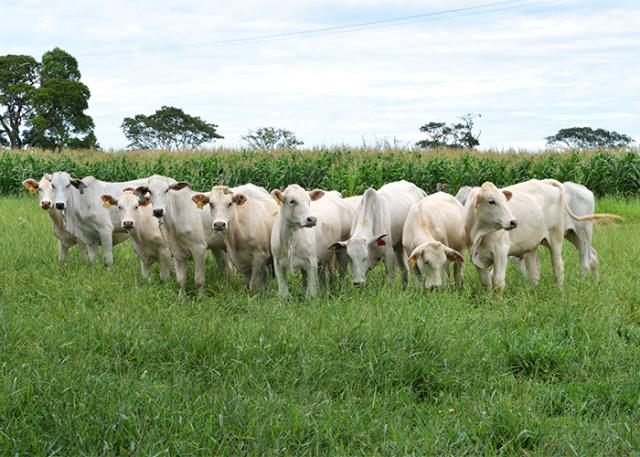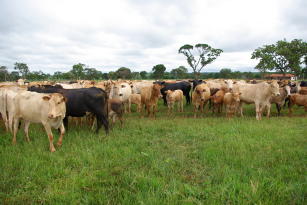Increasing beef production could lower greenhouse gas emissions in Brazil
19/01/16
|
Climate change
Increasing beef production could lower greenhouse gas emissions in Brazil
Contrary to expectations, a cut to greenhouse gas (GHG) emissions from cattle farming in the Brazilian Cerrado can be caused by increasing production, and reducing the activity may have the opposite effect, that is, higher emissions. These are the findings from a paper published this week on Nature Climate Change by researchers from Brazilian and Scottish institutions, which presents an innovative methodology to estimate greenhouse gas (GHG) emissions in livestock production. The authors have developed a mathematical model to assess the environmental impacts of variations in beef consumption in the Brazilian Cerrado livestock system.
Increased demand and policies to control deforestation have called for intensification in pasture areas. If such intensification encompasses the recovery of degraded pastures, there is a significant increase in soil carbon stocks, which, according to the study, would be enough to counterbalance increased emissions.
The study's main differential is the use of an innovative method called consequential life-cycle assessment, reports Embrapa Agricultural Informatics researcher Luís Gustavo Barioni. It considers emissions at every production stage, which includes emissions associated with inputs and transportation, similarly to traditional or attributional life-cycle assessments.
"We have included GHG emissions from all the production processed related to livestock production in the calculation, which allowed us to estimate the carbon footprint for beef in each scenario addressed by the model", adds Marília Folegatti Matsuura, a researcher from Embrapa Environment.
The researchers have also analysed the indirect consequences of the variation in meat consumption over soil carbon stocks. For that purpose, they have modelled beef production in the Cerrado, considering variations in demand and with deforestation data from the National Institute of Spatial Research (Instituto Nacional de Pesquisas Espaciais - Inpe) and by the Food and Agriculture Organization of the United Nations (FAO).
According to the mathematician Rafael de Oliveira Silva, a researcher at the University of Edinburgh and Scotland's Rural College who has developed the model with Barioni, the analysis included scenarios with different levels of impact of beef consumption on deforestation. In these scenarios, there has been a variation ranging from full decoupling, that is, no impact on deforestation, to a high level of coupling, with impact.
In the decoupled scenario, increases in demand associated with pasture recovery techniques have pointed to a reduction in emissions. Should demand be 30% higher than a reference projection for 2030, it would cause a 10% drop in total emissions. On the other hand, a 30% decrease in the demand for beef opposed to the figure projected for 2030 would cause a 9% increase in emissions.
"If the demand for meat increases while the deforestation rate is kept constant, farmers are required to intensify, that is, they are encouraged to recover degraded pastures, and that results in more soil carbon sequestration", Silva explains. "In fact, empirical evidence such as data from the Brazilian Agricultural Census, from Inpe, and from FAO, has shown that there has been a significan reduction in deforestation in all Brazilian biomes since 2005, while beef production continues to grow", he highlights.
The consequential life cycle is able to capture a rebound effect, and depict that a simple reduction in meat consumption would not necessarily reduce emissions, once demand is an important incentive to achieve lower emission intensities throught the adoption of pasture recovery techniques.
"In addition, our study corroborates recent research that demonstrates that the expansion of livestock production does not necessarily lead to increases in deforestation rates, provided that suitable mitigation techniques are used. According to such studies, Brazil already has enough pastures to meet the growing demand for meat without felling a single tree, at least until 2040", Silva adds.
If the demand grows larger, the carbon sequestration gain can compensate and have emissions fall. On the other hand, when demand is reduced, farmers tend to invest less in recovery and may even degrade pastures, which causes losses in soil carbon stocks. But if deforestation increases in the same proportion as demand, emissions will grow with consumption, as the researcher stresses. Therefore, controlling deforestation is essential to reduce emissions from livestock production.
Intensive livestock farming reduces emissions
Studies show that the best strategy to ensure the sustainable development of livestock production is intensification. The Brazilian agricultural sector has technologies available to increase efficiency as well as reduce greenhouse gas (GHG). The main strategies comprise the recovery of degraded pastures, best practices in forage and animal management, adequate use of inputs, genetic improvement, adoption of integrated systems (ICLF, ICL, ILF), and nutritional management.
Agriculture and livestock are responsible for 37% of national emissions, according to annual GHG emission estimates from the Brazilian Ministry of Science, Technology and Innovation (MCTI). Livestock production accounts for 14.5% of such total. The annual methane (CH4) emission average per head is 57 kg/animal/year. Actions to increase efficiency in production systems and improve animal performance can reduce this figure by 35%. According to Alexandre Berndt, a researcher at Embrapa Southeast Livestock, it is possible to reduce it to 37.7 kg/animal/year.
High animal performance favors reduced emissions from cattle. As Berndt explains, methane production depends on the quantity and quality of the feed digested, animal type, digestibility, and breeding conditions. Actions such as improving zootechnical indicators (i.e. reducing age at slaughter, calving intervals, and age at first calving), animal welfare, and the management of bovines and of pastures contribute to reducing methane emissions. On top of that, one could add nutritional management, with the use of grains and concentrates in their diet and the suitable processing of conserved forage so as to increase digestibility.
Research shows that soils lose more organic matter and release more quantities of carbon dioxide (CO2) into the atmosphere in degraded pastures. In terms of soil carbon loss alone, degraded pasture areas can present average emissions of four tons of carbon dioxide equivalent per hectare per year.
Meanwhile, as researcher Patrícia Anchão explains, pastures that are managed correctly sequester higher carbon quantities and contribute to increasing organic matter in the soils, improving fertility and forage quality. "The recovery of degraded areas and the adoption of integrated systems, like crop-livestock, livestock-forestry and crop-livestock-forestry systems, provide an increased stocking capacity and prevent the need to clear new areas for pastures", Patrícia points out.
AnimalChange
The paper "Increasing beef production could lower greenhouse gas emissions in Brazil if decoupled from deforestation" was authored by Rafael de Oliveira Silva, Luís Gustavo Barioni, Julian A. J. Hall, from the University of Edimburgh, Marília Folegatti Matsuura, Tiago Zanetti Albertini, from the University of São Paulo Luiz de Queiroz College of Agriculture (Esalq/USP), Fernando Antonio Fernandes, from Embrapa Pantanal, and Dominic Moran, from Scotland's Rural College (SRUC).
The results are part of the international research project "An Integration of Mitigation and Adaptation Options for Sustainable Livestock Production under Climate Change". The project known as AnimalChange, which is coordinated by the French National Institute for Agricultural Research, Inra, aims to assess the future of livestock production by 2050 and establish targets that ensure higher sustainability.
AnimalChange's goal is to develop techniques to integrate mitigation and adaptation options for a sustainable world livestock production. Their studies are conducted by a team of scientists from 25 institutions located in 18 countries in Europe and Africa, in addition to Brazil. The Brazilian members of the team are researchers from several Embrapa research centers and from the Federal University of Rio Grande do Sul (Universidade Federal do Rio Grande do Sul - UFRGS).
Pecus
To quantify greenhouse gas emissions from Brazilian livestock production and propose solutions to reduce them, Embrapa leads a research network that includes several national and international institutions - Pecus. The results from their work are going to be made available in 2016 and will contribute to the elaboration of effective propositions to lower greenhouse gas emissions and reduce global warming. "Studies in the scope of the Pecus network can adopt either the methodology or the model used in the Cerrado to assess livestock production systems in other Brazilian biomes", spotlights the researcher from Embrapa Pantanal, Fernando Antonio Fernandes.
Nadir Rodrigues (MTb/SP 26.948)
Embrapa Agricultural Informatics
Press inquiries
informatica-agropecuaria.imprensa@embrapa.br
Phone number: (19) 3211-5747
Gisele Rosso (MTb 3091)
Embrapa Southeast Livestock
Press inquiries
pecuaria-sudeste.imprensa@embrapa.br
Phone number: (16) 3411-5625
Collaboration: Marcos Alexandre Vicente
Embrapa Environment
Further information on the topic
Citizen Attention Service (SAC)
www.embrapa.br/contact-us/sac/


